Optical Snoots – A Review of 5 Options
21 Aug 2024, Posted by in Reviews, Uncategorized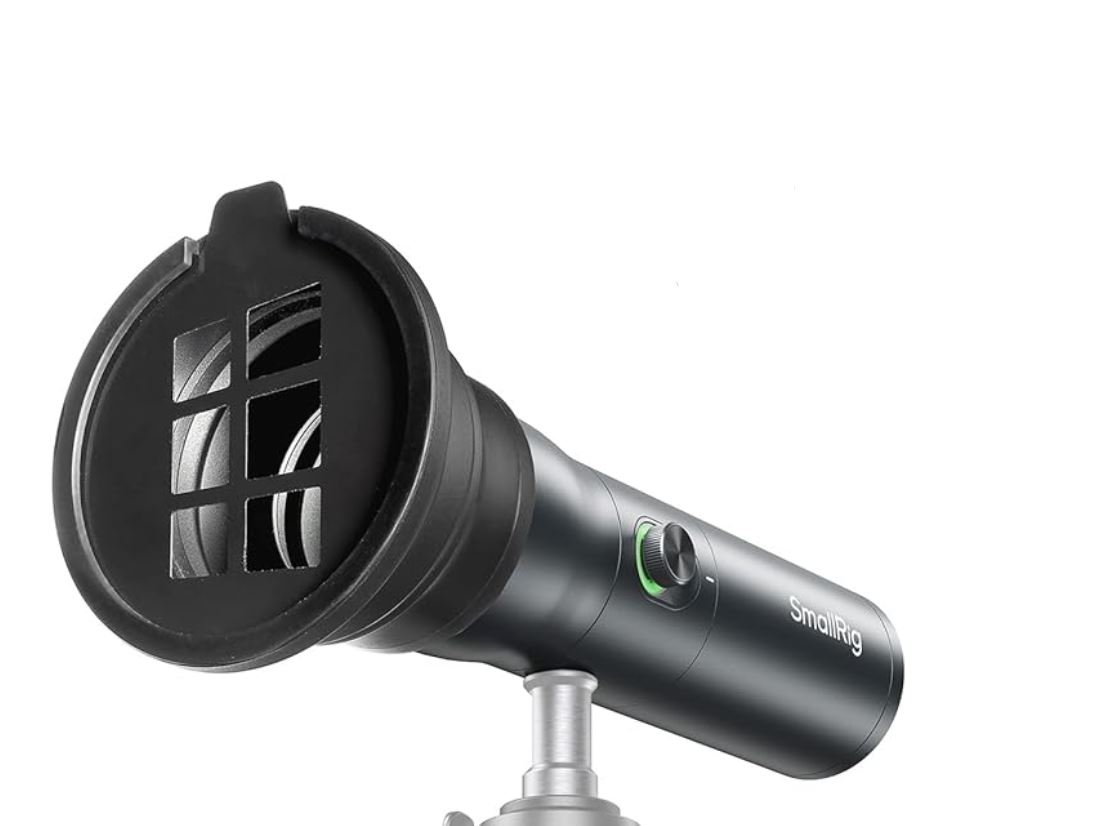
As cinematographers we are painters of light, The camera is simply a blank canvass. Optical snoots are great devices for shaping light, but up until just a few years ago snoots were too heavy, expensive, and unwieldy for small production teams. Not anymore, so today we’re going to look at five options for snoots, ranging from 60 dollars to well over a grand… and the question of whether the $500 Wescott Optical Spot is worth it’s price tag.
Before we jump in, let me clarify what an optical snoot is. Simply it’s a lens-based device for focusing light in such a way that a gobo (a metal sheet etched with a design) can be used to project a pattern of light against a surface. That pattern might be the shadow/light of a window, or a branch, or simply an abstract design that adds interest to a boring wall. It can be used to suggest what’s just beyond the frame. The “snoot” has been a common fixture in theatrical lighting for close to a 100 years (though it goes by a different name); they appear in nearly every stage production you’ll ever see. But you need a powerful, small source of light and a focus lens to project a gobo. Only since the development of powerful LEDs has it become a viable option for smaller production companies. Which brings us to the five options today.
We’ll be looking at the Smallrig RGB LED Photography Flashlight ($60), the Digitalfoto CINEPEER CX100 Optical Snoot ($65), the Lapgood Bowens Mount Projector Attachment ($140), the Fotoconic/Wellmaking Conical Snoot ($120), and the Wescott Optical Spot ($499). Unsurprisingly, each of these units have strengths and weaknesses, and the “winner” will be based on your use and current equipment.
Most Convenient, Least Practical
We’ll start with the Smallrig RGB LED Photography Flashlight. This unit differs from all the others in that it’s both light and optical snoot. There’s a lot to love with Smallrig’s RGB photo flashlight. The aluminum design is, frankly incredible: solid and elegant. I really like the green accent/power light around the single knob. The battery life is excellent as well. Three full hours at full strength beats any other battery light I own, and it’s more than enough for most interviews. The design is quite ingenious. At roughly 6 inches tall and 2″ in diamter it can fit nicely into a bag or lens pocket. The extending barrel will increase/decrease the width of the light design roughly 3x, and at its smallest aperture there’s about 1 stop increase in light. This is important because there’s really no other way to adjust the size of the gobo design other than moving the light itself. The snoot has a gobo holder built in, and it’s collapsible, making it easier to transport. The snoot is rubber and slips over the front of the flashlight (no locking mechanism but none needed), and the gobos fit nicely inside. All of these features are five star and above in my mind. But there are some limitations that will restrict the use of this nifty device. 10 watts is, obviously, not a lot, and that’s the primary drawback of this unit. You won’t want to position this light more than 6 feet from the wall surface it’s aimed at because there’s just not a lot of light being produced. Even at shorter distances it doesn’t produce enough light to make a sunlit window projection appear to be, well, sunlit. Sunlight through a window is bright and this unit is not. I wish Smallrig had gone with a 20 watt variable color temperature light rather than RGB. The RGB, for that matter, only lets you choose between Red, Green, and Blue for that matter; there’s no blending of colors (maybe an app will show up, but there’s no mention of Bluetooth). The second biggest issue for me is that there’s no way to focus the light. When it’s close to the wall the gobo is sharp; as it moves farther away it gets more blurry. This isn’t a deal-breaker because with 10W you can only move so far away if there’s any amount of ambient light in the room. The gobos construction/material is unique to this light, which is too bad, though on the plus side they’re plastic and it should be relatively easy to cut your own. The gobo designs themselves are just okay (the wattage and design of this light prevent it from working with smaller, more delicate designs– you just can’t get the image sharp enough at five feet). I wish Smallrig had made some other design choices, but they certainly have the opportunity to knock the next version of this snoot out of the park. As it stands, this photo flashlight is extremely portable and will work very well if you can position it just out of frame from below or the side… provided there’s not too much ambient light in the room. It’s a useful tool in the right circumstance, particularly if your goal is to add subtle interest to a boring background.
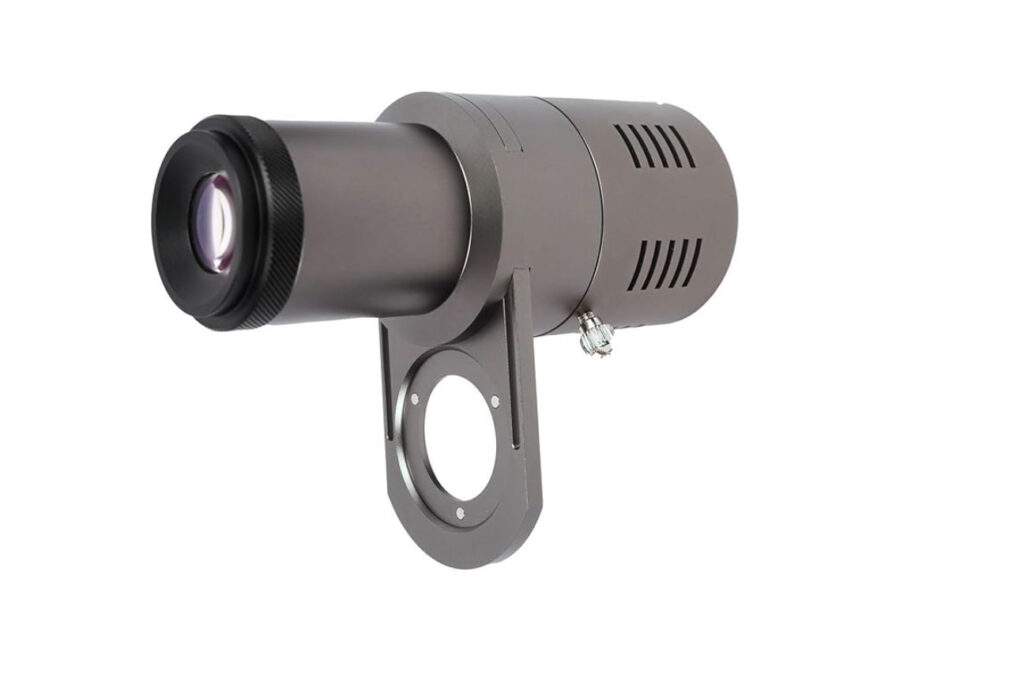
Second up is the Difitalfoto CINEPEER CX100. Unlike the Smallrig, this is designed to attach to a separate light. The Zhiyun is a mini Bowens mount attachment, but there is, unfortunately, no universal size for mini Bowens. The Zhiyun comes with two adapters to maximize the number of lights it will work with, but you can only be confident that it will attach to Zhiyun, Smallrig, and Ulanzi mini bowens-mount lights. These, in turn, are restricted to 60-100 watt output (currently). I did successful attach the Zhiyun to a “NULBOFU” 40W light using the Smallrig adapter, so there are other compatible lights. The Digitalfoto is a surprisingly tiny optical snoot, smaller than many lenses. It’s hefty– made of metal and glass, and very well built. Some optical snoots reduce the amount of light significantly, and I was happy to see that this isn’t really the case. You can get a very solid output of light from a 100W instrument. If you own a mount-compatible light, this would seem to be a slam dunk… but there are a couple of aggravating shortcomings. The dual sliding gobo holder, while ingenious, makes it more difficult to fit into a camera bag (and frankly I don’t see the point of having a second design loaded and ready to go). A single gobo holder would allow it to fit into a lens compartment. Unfortunately, they do not provide any “practical” gobo designs, such as blinds or windows, which would be more useful on commercial shoots. The 14 included deisgns are largely abstracts, or nonsensical images like fire, moon behind clouds, lightening, etc. The gobos are smaller than I’ve ever seen (and I’m a professional lighting designer), which means the Digitalfoto will not work with other gobos; your only option is to make your own. But, if you’re willing to practice your slicing skills on a pie tin— or if you’re happy with abstract patterns— it’s a neat compact kit at an excellent price. You can read the dedicated review here.
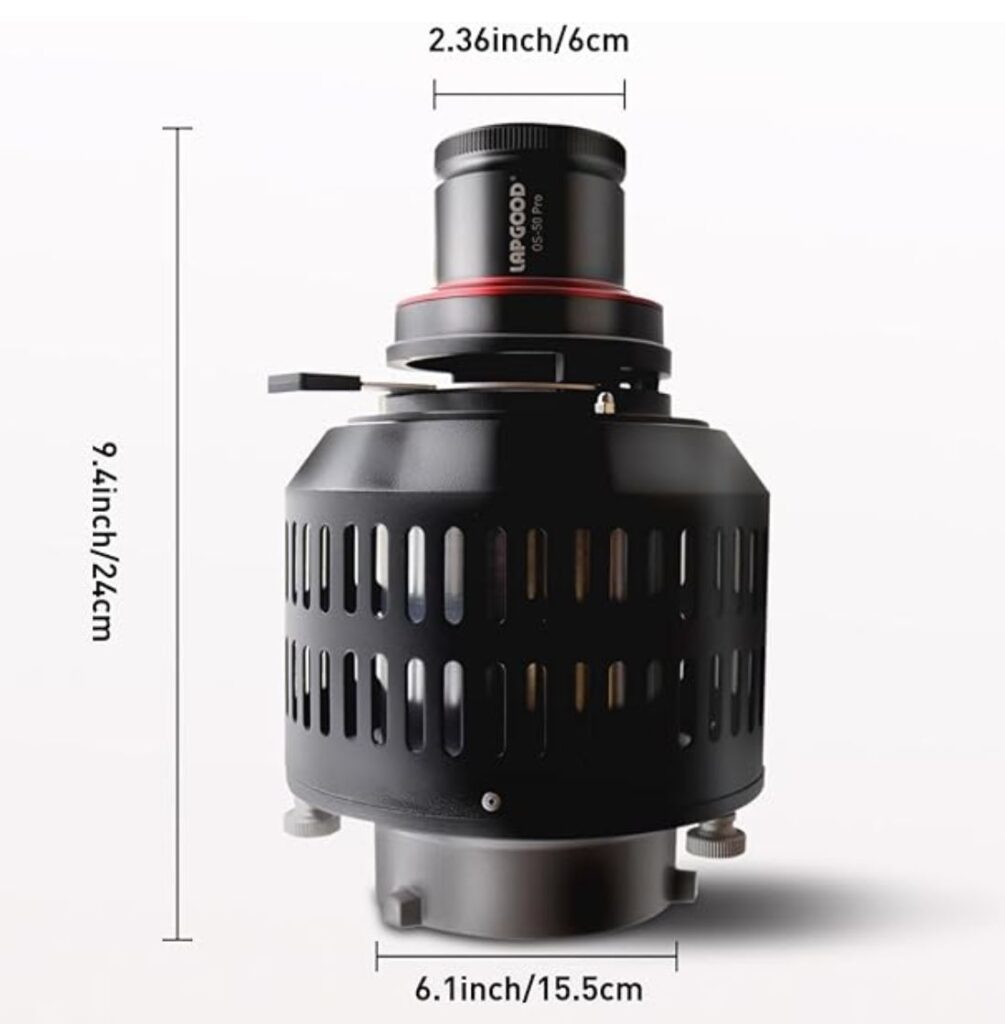
The Lapgood optical snoot is the first of the bunch to work with a standard size gobo, and it comes with a number of useful ones in the box. Like the Digitalfoto, the Lapgood attaches to an existing light. It’s all metal construction is pretty solid, but I’d be uncomfortable using a 200W light at full power for an extended period of time. It’s going to get extremely hot, and there are a few plastic components in the focusing ring. Anything up to 300W will probably be fine, and produce a healthy amount of light. The Lapgood comes with a focusing lens and it does diminish the light output too much. I suspect it’s the equivalent of a F1/8 lens. Since it’s designed for a light, the lens isn’t perfect and there are a couple of aberrations. This, however, is pretty true to reflections in life, though. The mount is a true Bowens, and has no difficulty fitting on any of my lights. What I like best about the Lapgood model is that the included gobos, which are high quality metal, include a fair number of practical designs. These are largely different windows and blinds (as well as a slot), and there could be more variety (such as foliage); but Lapgood understands what nearly every other manufacturer gets wrong. That the main use of a gobo is to reproduce practical/real-life light patterns, not abstract ones. For $140, the Lapgood has only a couple of shortcomings. The gobo holder doesn’t lock into place, allowing it to fall out if you rotate the light, or are just carrying the snoot from one location to another. It’s also fairly heavy, which is something to consider when matching it to a light stand (this is also true of other full-sized optical snoots). And being a single-size lens, there’s isn’t a great deal of “throw” to the light. The pattern becomes too big after 10 feet or so. It’s an excellent choice for small to mid-sized shoots, but not for large locations or productions.
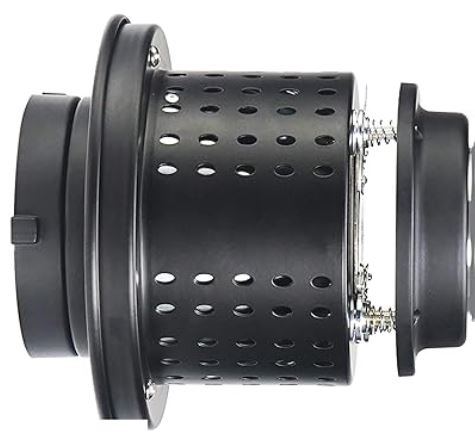
The Fotoconic/Wellmaking Conical Snoot is the first of the bunch to solve the distance-size challenge. This optical snoot is nearly identical to the Lapgood in design, except that it doesn’t have its own focusing lens. Instead, you provide, attaching a cheap, fast lens to the front. Having to provide your own lens is an extra expense, of course, but it allows you to connect a telephoto lens which can throw the pattern a long distance without it either becoming too big, or reducing the amount of light. A 100mm telephoto lens projected against a wall 20 feet away will produce a pattern that is the same size and just as bright as a 50mm lens on a wall 10 feet away. This flexibility comes at a cost in terms of needing more than one lens that can attach to the front (you can buy adapters for different lens manufacturers) as well as slightly more fuss. Fotoconic and Wellmaking make identical versions of this snoot; currently the Wellmaking is easier to find. These have standard Bowens mounts for any light. The construction is all metal, but I’d still be reluctant to blast a 200W light at full power through it for an extended period of time. These snoots heat up in a very disconcerting way, and camera lenses aren’t designed for temperatures that would burn your fingers. At 120 dollars plus lens(es), you’re starting to make a real investment in this modifier. A few years back (right after it was introduced) I made a video review of this snoot.
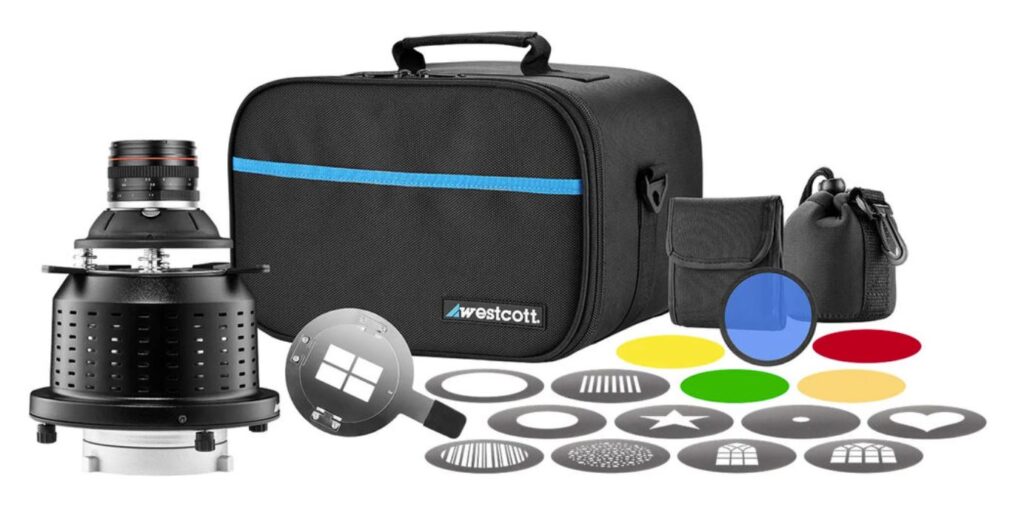
To understand value, it’s helpful to compare these to a more established brand like Wescott. Their Optical Spot (by Lindsay Adler for Bowens— what a name!) has been around for a few years.The kit incloes 8 gobos, five jells, a nice carrying case, and the option to choose either a 50mm f/1.4 lens (for smaller spaces) or a 150mm f/3.5 lens for big rooms. The 50mm lens appears to be just a straightforward Canon lens, whereas the 150mm has a custom housing with Lindsay Adler’s name on it. The snoot without the lens is virtually identical to the Fotoconic housing… right down to the funky gobo clip system that seems weirdly over-engineered. As packaged by Wescott, the kit is a nice neat affair with several cases and pouches to hold the gobos and lens, but the functioning bits are the same quality as its cheaper cousins, the Fotoconic/Wellmaking and Lapgood. And like those two, Westcott recommends that it’s Optical Spot be limited to lights under 100 Watts for fear it will melt the lens. It isn’t that the Wescott is poor quality; it’s that the Chinese companies entered the market later once the construction was worked out. Is the Wescott worth the extra $350? I think the answer is obvious.
So which would I buy? Well, I already own the first four units so the question is really which am I more likely to pack up and use? In this review, I listed the lights in order of ease of use and functionality. The Smallrig is by far the easiest to carry and setup, but due to its minimalist light output it’s the least functional of the bunch. I’m likely to grab it for a small indoor shoot if I’m not sure I’ll need a snoot. It’s that easy to carry. The Wescott, on the other hand, is pricey without adding much value. Both the Digitalfoto Cinepper and the Lapgood find a nice balance here, with moderate power and flexibility; though it’s important to remember that the Lapgood snoot is already the size of your average LED light (which has packing considerations) and the Digitalfoto only works with certain mini Bowens mounts. In many respects, this list is also in order of the amount of time you have for your set-up. For me, the pre-production planning helps guide my choice of which snoot is best, and there’s no “everything, everywhere” solution. At least not yet.
Sorry, the comment form is closed at this time.